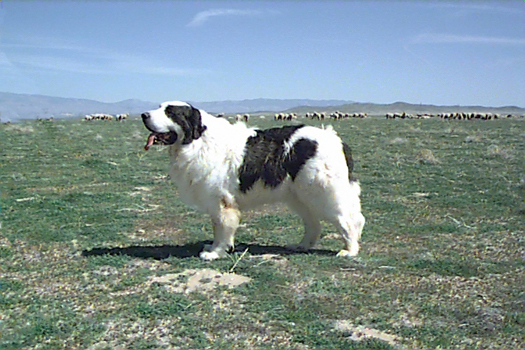




Ch. Zoy - Minero de la Tajadera del Tio Roy (Photo by De La Tierra Alta)
OFFICIAL STANDARD/MASTIN DEL PIRINEO PYRENEAN MASTIFF
Origin: Aragon and Navarra Pyrenees.
Use: Mainly as a defendor for cattle and guardian of people and property.
FCI Qualification: Second Group, Section 2, Molossers. Short history of the breed: Its existance is very much related to the defence and guarding of herds and cattle in Navarra and Aragon, both trashumant or stable.
1. General appearance: Its a large size dog, well proportioned and muscled, with a compact skeleton and although large in size it shall never be cumbersome nor lymphatic.
2. Important proportions: Length of the muzzle/length of skull = 5/4. Height to withers/brisket perimeter = 7/10.
3. Behavior and character: Meek, docile and extremely intelligent. It is very brave and fierce with strangers. It shows extremely benevolence with other dogs knowing of its strength. Should the time arise it is skilled at fight, remembering its acquired behaviour in the fight with wolves. It has a deep and intense bark.
4. Head: Large, strong and moderately long. The skull - face look will be uniform and showing no specific difference in width when seen from above. From aside it will look deep, not wolf like. There will be a soft but defined stop. The width of the skull will be equal or slightly superior to its length and the occiput crest will be well marked. Seen in profile the face will look somewhat triangular, large and slightly diminishing towards the truffle, never looking snipey. Eyes: Small, hazel or preferably dark, showing severe aggressiveness when gazing at strangers and yet sweet to friends. The eyelids will be black and preferably close to the eye when the dog is in attention; when resting, the lower eyelid lets show a small part of the conjunctiva. Ears: Medium sized, V-shaped, plain and inserted well over the line; when alert they should be separated from the face and partially lifted. Shall never be amputated. Mouth: Scissor bite; with rather small incisors compared with the size of canines and the strength of the molars. Will have all the premolars.
5. Neck: Wide, strong, muscled and flexible, with a double well defined gill but exagerated.
6. Body: Rectangular, strong and showing great power. Wide chest and a well marked breastbone, round brisket and well separated cutlets. The back will narrow to the hips.
7. Forequarters: Straight and paralell when viewed from the front, showing muscles and tendons; with well muscled and obliquous shoulders, longer than forearms. The elbows are tied to the brisket. The forearms will triple the pastern in size.
8. Hindquarters: Adequate ear angulations, strong and muscled, heavily boned, with well marked hocks, showing the tendon and with no deviations.
9. Feet: Cat feet, slightly oval, may show single or double spurs, that can be amputated if desired, although when choosing between two similar dogs, the one showing double spurs, will be preferred.
10. Tail: Strong at the root and medium set, strong, flexible and showing an important panache; reaches the hocks when resting and while moving it will be held as a sabre, rather curled at the bottom but never totally folded and not resting over the hips.
11. Coat: Halflong, thick and laying flat to the body, the ideal medium length will be of 6 to 9 cms at the middle of the back and longer at the shoulder, neck, stomach and behind hind and forelegs, as well as in the tail panache. Never wooly.
12. Color: Basically white and always with a well defined mask, marks similar in color to that of the mask spread over the body, with irregular but well defined shape. Ears always marked. Totally white or tricolored animals not preferred; the most appreciated colors are pure white, snow white with medium grey marks, deep gold-sand, dusk, black, silver grey, light tan, sand, brindle, red for the marks or yellowish white for the whole not desired.
13. Gait: Trot is preferred and will be powerful with a sense of purpose and straight, never plaiting.
14. Weight and size: There are no limits to the maximum height and those animals that are taller whenever proportioned will be preferred. Minimum height will be 77 cms for the males and 72 for the females, but it will be preferred that males reach minimums of 81 cms and females 75 cms.
15. Faults: Sheepy head and face; lack of a premolar, slight distortion of the backline when moving; slight shyness; slightly curly or more than 9 cms long coat. Serious faults: Snipey or excessively rounded muzzle; weak bone; incorrect laying of the quarters; moderate enognatism; the absence of several premolar or canine teeth if the cause is other than accident; roach back; loins much taller than withers; very curly coat or whenever less than 6 cms or over 11 cms; no mask or depigmented ears; ears or tail cut. Exagerated ectropion or entropion; tail leaning over the back, with no panache, or straight at the end. Fragile and lymphatic appearance; unstable character. Eliminating faults: excessive prognatism or enognatism; lack of pigmentation at the truffle and mucosa; the absence of white coat; no white markings at the quarters and toes. Absolutely white specimens; absence of mask. Coat shorter than 4 cms or longer than 13 cms. Monorchid or cryptorchid animals. Any marks that are not clearly noticed and could mean mongrel blood.


